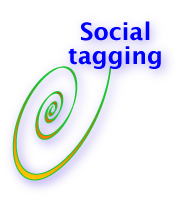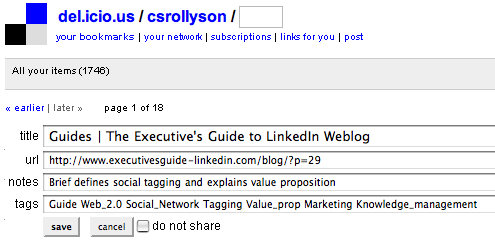 This article will explain something that’s probably been nagging at you for some time: what in the world are all these little icons that seem to be popping up everywhere?
This article will explain something that’s probably been nagging at you for some time: what in the world are all these little icons that seem to be popping up everywhere?
These little icons take you to various social tagging and bookmarking systems, which are an exceptionally powerful Web 2.0 phenomenon that is under the radar in 2008 but has immense potential for enterprises and individuals. Emerging social tagging solutions offer marketers an excellent means to enable customers to help each other and improve a wide range of Website metrics. The most well known tagging/bookmarking sites are B2C: Del.icio.us, Furl, Netvous, Bluedot and Ma.gnolia, but tagging has a solid B2B value proposition as well.
First, a little background. Social or public bookmarking began during Web 1.0 (Internet boom) as a way for people to share their favorite Web pages: instead of saving bookmarks on their computers, members would save bookmarks on the Web, so other people could find and use their bookmarks to find interesting content. For example, you represent a tire company that is interested in setting up a channel in China, but you don’t know much about selling tires in China. Conducting preliminary diligence, you search Del.icio.us, and you find a couple of people who have bookmarked numerous articles about channel strategies, business conditions and political angles in China. A terrific time-saver because members reuse each other’s collections of articles on very defined topics. As you might suspect, my bookmark collections are focused on social networks, Web 2.0, innovation, professional services and (you probably wouldn’t guess this) cross-border mergers and acquisitions.
That may sound like a quaint geeks-only activity until you consider that the same technology can allow your customers to tag products on your e-commerce site to help other customers find them more quickly. Likewise, employees can tag content to juice up returns for knowledge management (KM) investments. Business development teams can collaborate and share all kinds of content that can directly help them to increase relevance and effectiveness. The list is endless, but it revolves around this simple concept: tagging is a one-click way for people to create information that helps themselves and other people to find and use content.
Overview of the Concept
Frankly, social bookmarking didn’t become very interesting until companies like Del.icio.us began using tagging for their bookmarking systems. Bookmarks are comprised of tags, links and notes (see “Under the Hood” below). Bookmarking 1.0 itself was a legacy concept that was natural extension of the desktop file/folder concept. It was very limited because, if a bookmark was in one folder, it couldn’t be simultaneously in another. For example, you could bookmark this post, but you would have to choose what folder to put it in. You might want to include it in Web 2.0, bookmarks, organization tools or Internet, but you would have to choose. The organization system ultimately got in the way.
Tagging is an exciting Web 2.0 technology and idea that helps people “tag” content (picture, blog post, Web page, video, song, etc.) so that they can find it later, almost like highlighting a book or using sticky notes to protrude from a book’s pages with little notes written on them reminding you of what you found interesting or related thoughts. Tags are hot linked, so when you hit a tag it returns all the content that is tagged with it. Even better, you can put as many tags on a piece of content as you wish and you make up the name of the tags. You could tag this post with all the choices I mentioned earlier or terms of your own; in addition, most tagging sites will suggest tags for the content you are viewing (you can see what others tagged this content), and you can include a memo about what you found interesting. Moreover, you can go back and rename your tags in the future (let’s say you tagged this “Internet 2007” a while ago, and you want to rename “Web 2.0”). Change it, and all the “Internet 2007” tags are renamed. Moreover, you can search your tags (useful when you have thousands), and you can create groups of tags (you could group “blogs,” “wikis” and “social.tagging” within a supercategory “Web 2.0”). You can connect with other people with similar interests. Below we will put this in B2B and B2C commercial contexts.
Under the Hood
For example, here is my tag for this post. When I hit the del.icio.us icon, the link takes me to my del.icio.us account, where del.icio.us has automatically filled in the title and url. I include the tags I want and notes. When I hit “save,” del.icio.us returns me to the page, and that bookmark is saved in my del.icio.us account, where I can find it at any time, and other people can find it, unless I have hit the “do not share” box. Of course, everything about bookmarks is searchable, so members can easily find and share each other’s bookmarks. You can learn more about how del.icio.us works here.
Summary
- Features
- Allows people to think and share how they want to.. in one click
- Unlike folder taxonomy, tags are not mutually exclusive and help people find content
- Emergent organization is naturally agile
- Very effective at discovering and tagging ideas and trends as they appear
- Add more tags without removing old ones.. add tags to any digital content
- Instead of browser bookmarking, tag for all in the enterprise to use
- Avoid rampant duplication of research efforts
- Not limited like folder metaphor in which you can only put something in one folder
- Prevalent uses:
- Research and project teams collectively find and “tag” information
- Business development conducted by disparate teams
- Collaboration with clients and partners
- Customers tag content to guide each other to the products they want
- Vendor examples: Del.icio.us, Furl, Netvous, Bluedot, Ma.gnolia
Business Applications
There are myriad business uses for tagging, but here are some major ones you might want to try this year:
- E-Commerce sites—some major B2C sites that use tagging are: ACE Hardware, Amazon.com, Brookstone, RadioShack, Sheraton, Staples, Toys “R” Us, Walgreens and Yahoo! Travel. By implementing tagging on their sites, they are enabling customers to add their notes and guidance for other customers. For example, customers might tag a certain hammer on ACE’s site as “roofing” because ACE’s copywriters didn’t think of the product from the customer’s point of view. Even if only a dozen out of millions of viewers tag it, that can add immense value. More customers find it with fewer clicks and buyers tend to return items less often because they know what they are buying. When combined with product reviews (like amazon.com), tagging can significantly improve your metrics.
- Intranets—by the same token, corporations have been constantly frustrated at the persistent lack of content reuse and duplication of effort. Having worked in two of the world’s most esteemed consultancies, I have seen consulting teams create reports and other deliverables from scratch because it is simply too difficult to find existing content, even though everyone knows it’s there. Tagging is an in-context, employee-centric means for people to mark content for themselves (and by extension for others). Since it is in-context, it is more relevant to other customers who are in the same context. It isn’t a “KM system” that you need to add content to as a separate process. Amazon.com’s reviews are also in-context of the buying business process and are therefore much more powerful.
- M&A deal teams—the same argument as consulting; teams are under pressure to produce and they cannot find existing content, so they recreate. Based on considerable employee costs, I think you might appreciate that the ROI is very interesting.
- Surveys of customers—customer input is inherently customer-focused, and it can supplement your company’s information, especially when you know how to present the information.
- For more detailed explanations, see “Social Tagging, Changing the Economics of E-Commerce: Customers Help You to Boost Revenue.”
Barriers to Adoption
- If you have read our other guides, you will note that this one is longer because, although tagging is simple to do, it is not easy to explain or to understand. Few executives are even aware of it.
- Fear about how people might tag your content. Tagging is a basic form of “user-generated content” and carries its inherent risks. However, these risks are eminently manageable when you put appropriate processes in place.
- Not understanding the value proposition or the concept—how can customers (or employees) help each other? Tagging doesn’t seem very significant, and it is difficult for most people who haven’t done it to understand how it can help.
- It appears geeky and frivolous—most business people think in terms of big numbers. “No one has time to fool around tagging our products. This couldn’t work!” Tagging reflects the Web 2.0 concept that a few exceptions can have an immense impact. If your site has 1,000,000 or 100 viewers per day, if only .1% of your viewers tag once a month, that still adds up to a lot of tags, and you pay little to no marginal cost.
- Overlooking relationship—when customers tag, they deepen their relationship with and commitment to the company.
Learning More
If you are interested in learning more about social tagging and bookmarking, or how to use it, I’d be glad to discuss with you to see whether using it might make sense for what you’re trying to accomplish. I help companies to plan, create and execute communication programs using Web 2.0.
*But were afraid to ask ,^)


Creating Strategic and Tactical Value with Enterprise (Social) Networks…
Leveraging B2C "Social" Networks for Real Enterprise Advantage—Flashbacks to Web 1.0
Pan in, circa 1998, and enterprises were beginning to doubt the conventional wisdom that had prevailed during the past three years, namel…